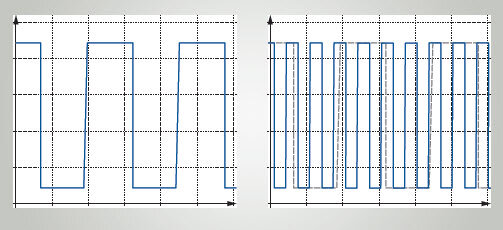
Electrical motor vehicle signals
Increasing importance of the oscilloscope
Information on diagnostics
An ever-increasing number of vehicle components communicate using clocked signals.
What is the difference between PWM (pulse width modulation) and PFM (pulse frequency modulation) signals?
Can clocked signals be measured with a multimeter?
Pulse width modulation (PWM)
- The frequency is constant.
- The pulse duty factor, i.e. the width of the pulses, varies.
Pulse width modulation may be used as a signal input factor or for the power control system, e.g. for EGR valves, throttle valves, electro-pneumatic valves, idling actuators or for demand-controlled fuel pumps.
Pulse frequency modulation (PFM)
- The frequency varies, i.e. the signal curves are compressed or elongated.
- The pulse duty factor is constant.
On some Pierburg air mass sensors the output factors may be output as PFM signals.
Synchronised signals on the oscilloscope screen
- Voltage U, in volts
- Pulse or ON time
- OFF time
- Period duration T
- Time axis, in seconds
- The frequency is inverse of the period duration: f = 1/T
- “Pulse duty factor”
The pulse duty factor is shown as a number between 0 and 1 or a percentage value between 0% and 100%.
Some oscilloscopes, as in the example here, show the pulse duty factor “upside”, in other words the OFF time (3) in relation to the period duration (4).
Synchronised signals are relatively insensitive to faults. Faults in the signal fl ow, for example due to corrosion or moisture in the plug-in connections, may cause the voltage level (8) to vary. This does not aff ect the actual “pulse duty factor” or “frequency” data.
